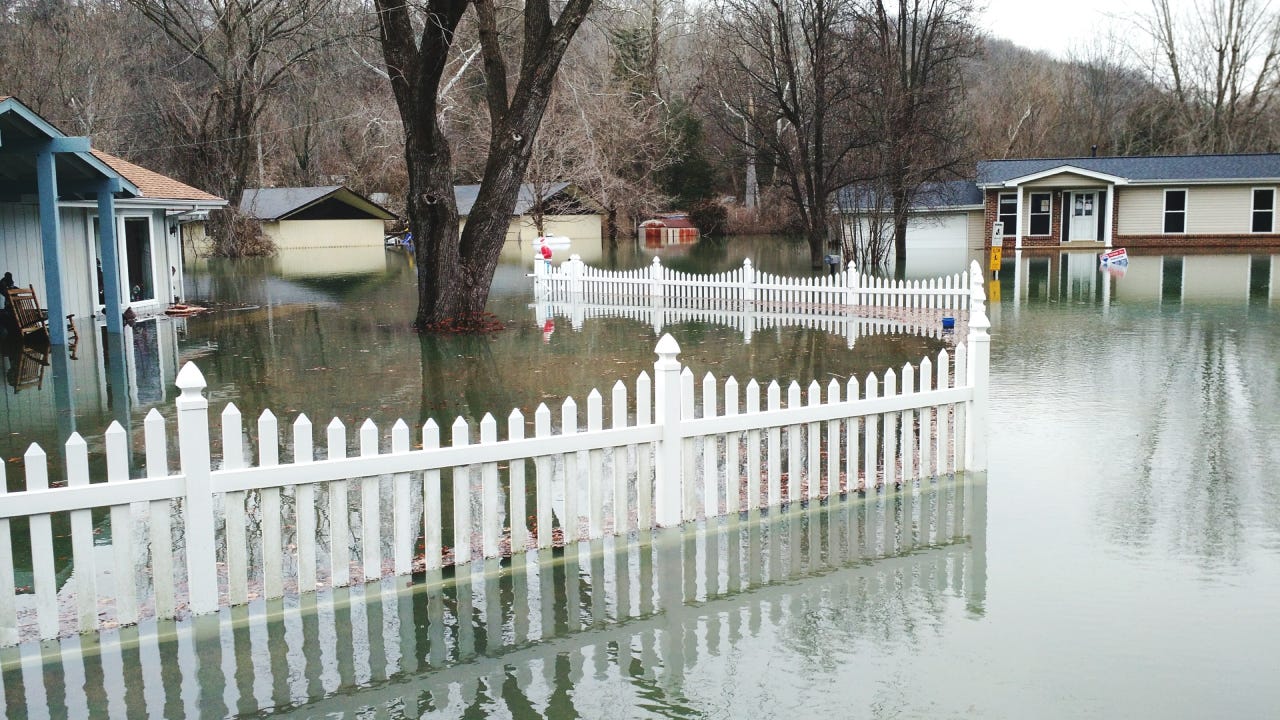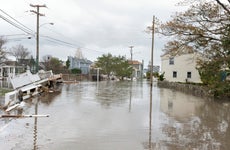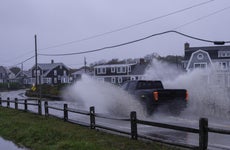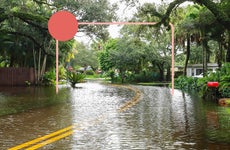Understanding FEMA’s Risk Rating 2.0 system for flood insurance

The Bankrate promise
At Bankrate, we strive to help you make smarter financial decisions. To help readers understand how insurance affects their finances, we have licensed insurance professionals on staff who have spent a combined 47 years in the auto, home and life insurance industries. While we adhere to strict , this post may contain references to products from our partners. Here's an explanation of . Our content is backed by Coverage.com, LLC, a licensed entity (NPN: 19966249). For more information, please see our .
Key takeaways
- Risk Rating 2.0 changed how FEMA calculated NFIP policy prices so that insurance rates more accurately reflect an individual property's flood risk.
- FEMA Risk Rating 2.0 rates were not expected to dramatically change for most current policyholders. Rate increases are capped at 18 percent per year.
- From 1996 to 2019, 99 percent of U.S. counties experienced at least one flooding event.
As of April 2023, the Federal Emergency Management Agency (FEMA) has fully rolled out its Risk Rating 2.0 program. Risk Rating 2.0 is the new way FEMA prices flood insurance policies. Unlike the old system, Risk Rating 2.0 considers each property’s individual flood risk, rather than just placing homes in different location- and property-based risk categories.
Understanding this rating system might help you understand your flood insurance rates and determine whether flood insurance through the National Flood Insurance Program (NFIP) or a private insurer is better for your home.
What is FEMA Risk Rating 2.0?
Risk Rating 2.0 is the new way FEMA sets prices for NFIP flood insurance policies. FEMA had previously been using an outdated model for determining flood insurance costs.
Modern science, years of data and the inclusion of third-party software, data sets and models have allowed FEMA to create a far more accurate system for determining flood risks and the associated costs. Risk Rating 2.0 is a new approach that takes into account numerous variables, such as individual home value and flood risk, that were not previously factored in.
The average annual cost of flood insurance from the NFIP was $700 per year, but under the new system, policyholders pay on average $800. The idea is to have rates increase or decrease until annual premiums match the actual risk-based cost of flood insurance. However, rate raises are capped at 18 percent per year.
Implementation of Risk Rating 2.0
FEMA rolled out Risk Rating 2.0 in two phases:
- Phase 1: This began October 1, 2021. During this phase, new NFIP policies began using the new pricing methodology. Existing policyholders who were up for renewal could also begin benefiting from Risk Rating 2.0.
- Phase 2: The second phase began April 1, 2022 and applied the new rating system to all existing policies as they came up for renewal. This phase completed on April 1, 2023, and the plan is now fully rolled out.
Why FEMA updated flood insurance rates
FEMA had previously been using an outdated model for determining flood insurance costs. Before, FEMA relied on groups and categories to assign flood insurance rates, as opposed to more individual factors. When the NFIP began in the 1970s, flood rates were based mostly on flood zone, property elevation and occupancy type. Original flood rates also only considered river and coastal flooding.
Risk Rating 2.0 takes a more comprehensive and individualized look at a property’s flood risk in order to set premiums that more closely reflect the insurance risk. Here’s what Risk Rating 2.0 looks at in order to set flood insurance rates:
- Pluvial flooding (flooding from rainfall)
- Distance from water
- Type of flooding
- Flood frequency
- Structure foundation type
- Replacement cost value of a building
- Claims history
- Height of lowest floor compared to Base Flood Elevation (BFE)
What didn’t change under NFIP’s new pricing approach?
The new Risk Rating 2.0 pricing strategy kept some key elements consistent to ensure a smooth transition and meet legal requirements. The NFIP must adhere to the existing legal caps on annual insurance premium increases, ensuring that qualifying rates don’t surge by more than 18 percent annually. FEMA still uses Flood Insurance Rate Maps (FIRMs) for mandatory purchase requirements and floodplain management. These FIRMs still serve as a vital source of flood mapping data for communities. Lastly, FEMA has continued offering premium discounts to eligible policyholders.
Flood insurance rate changes by state
The new Risk Rating 2.0 system was predicted to cause minor rate changes for most policyholders, but some areas did see larger than predicted changes. While Risk Rating 2.0 is designed to be a more fair, equitable rating system, rates will still depend on a home’s individual flood risk. The higher your risk, the more you’re likely to pay.
Even within a state, there is often significant variance between locations. With the new system, more variables go into each rate calculation than before. In some cases, flood prevention steps may be taken to help mitigate the risk of flood damage and potentially reduce rates. Risk Rating 2.0 has also factored in the risk of different types of flood exposures that may cause damage to residences. Of the more than 3 million single-family policies in force as of August 2023, here is the percentage breakdown between the five main exposure risks:
- Inland flood: 100 percent
- Storm surge: 60.7 percent
- Tsunami: 1.1 percent
- Great Lakes: 0.2 percent
- Coastal erosion: 7.9 percent
Will my rates increase with Risk Rating 2.0?
While many NFIP policyholders saw a rate increase, the ultimate goal is to have policyholders pay the appropriate rate for their policies. By law, NFIP policies for primary residences have a rating increase cap of 18 percent per year. FEMA states that policyholders are on a ‘glide path’ to have their current cost of insurance eventually match the calculated risk-based cost of insurance. Under Risk Rating 2.0, flood insurance premiums are likely to change, but that does mean they will always become more expensive. Below, we’ve rounded up statistics on how NFIP flood insurance premiums have changed for single-family homes since Risk Rating 2.0 rolled out:
- 18.5 percent of homes saw premiums decrease
- 71.7 percent of homes saw premiums increase by $0 to $10 per month
- 6.9 percent of homes saw premiums increase by $10 to $20 per month
- 2.9 percent of homes saw premiums increase by more than $20 per month
FEMA has undertaken Risk Rating 2.0 to correct inadequacies in the legacy rating from the 1970s and implement a rating approach that more equitably distributes flood insurance premiums across all policyholders based on a home’s replacement cost and a property’s specific flood risk so that premiums are more accurate and equitable. Under the old legacy rating, FEMA would have increased premium rates for every policyholder within a broad rate category indefinitely, regardless of whether the actual risk of flood to the property warranted such an increase, thereby continuing to unfairly increase premiums on policyholders with lower value properties
— David Maurstadsenior executive of the National Flood Insurance Program
FEMA terms policyholders need to know
| Risk-based cost of insurance | This is the full actuarial rate calculated by FEMA under the new risk plan based on expected losses. Due to state subsidies, most policyholders pay below this amount. |
| Current cost of insurance | This is the premium that policyholders currently pay. Since the rate can not increase by more than 18 percent a year, premiums will increase until it matches the risk-based cost of insurance. |
| PIF | This stands for policies-in-force, meaning the current amount of active insurance policies held by any particular insurance provider. In this case, the amount of active NFIP policies. |
| Average RCV | The average replacement cost value to rebuild a home after a total loss. This estimate accounts for the cost of parts, labor, location and square footage. |
Below is a chart showcasing the per-state current cost of insurance vs. the risk-based cost of insurance. According to NFIP, once policyholders’ current costs match the risk-based costs, their policy should not increase again until the risk-based cost is recalculated.
Note that an NFIP policy is not a guaranteed replacement cost policy and has a maximum coverage limit of $250,000 for single-family homes.
Summary of single family homes under Risk Rating 2.0 as of Sept. 30, 2023:
| State | Average risk-based cost of insurance | Average current cost of insurance | Average replacement cost value (RCV) |
|---|---|---|---|
| Nationally | $1,808 | $800 | $543,017 |
| Alabama | $2,051 | $986 | $457,660 |
| Alaska | $543 | $633 | $543,419 |
| Arizona | $1,443 | $878 | $489,192 |
| Arkansas | $1,583 | $815 | $356,538 |
| California | $1,689 | $1,031 | $651,665 |
| Colorado | $1,644 | $1,052 | $630,302 |
| Connecticut | $3,000 | $1,298 | $785,257 |
| Delaware | $1,497 | $1,039 | $666,406 |
| Florida | $2,213 | $953 | $519,678 |
| Georgia | $1,332 | $803 | $513,222 |
| Hawaii | $3,653 | $1,266 | $681,682 |
| Idaho | $1,633 | $951 | $575,493 |
| Illinois | $1,697 | $995 | $550,698 |
| Indiana | $1,361 | $896 | $434,676 |
| Iowa | $1,679 | $956 | $363,232 |
| Kansas | $1,569 | $820 | $413,218 |
| Kentucky | $1,569 | $1,279 | $389,187 |
| Louisiana | $1,904 | $871 | $515,620 |
| Maine | $2,700 | $938 | $583,020 |
| Maryland | $742 | $657 | $584,316 |
| Massachusetts | $2,097 | $1,084 | $721,801 |
| Michigan | $1,068 | $798 | $455,227 |
| Minnesota | $1,832 | $919 | $567,157 |
| Mississippi | $2,137 | $841 | $452,248 |
| Missouri | $2,038 | $1,167 | $469,098 |
| Montana | $1,656 | $891 | $456,860 |
| Nebraska | $1,323 | $849 | $387,325 |
| Nevada | $1,031 | $980 | $500,128 |
| New Hampshire | $2,545 | $1,150 | $523,352 |
| New Jersey | $2,129 | $1,274 | $677,595 |
| New Mexico | $1,344 | $910 | $387,276 |
| New York | $2,197 | $1,105 | $865,963 |
| North Carolina | $1,363 | $874 | $468,062 |
| North Dakota | $1,342 | $750 | $532,104 |
| Ohio | $1,303 | $961 | $418,251 |
| Oklahoma | $1,683 | $796 | $403,990 |
| Oregon | $1,969 | $946 | $463,414 |
| Pennsylvania | $2,060 | $1,203 | $516,345 |
| Rhode Island | $1,503 | $917 | $659,355 |
| South Carolina | $1,531 | $740 | $572,111 |
| South Dakota | $2,062 | $873 | $517,151 |
| Tennessee | $1,664 | $1,011 | $479,330 |
| Texas | $1,405 | $784 | $524,545 |
| Utah | $953 | $639 | $644,148 |
| Vermont | $2,248 | $1,221 | $515,615 |
| Virginia | $1,077 | $1,034 | $540,494 |
| Washington | $1,782 | $996 | $511,725 |
| Washington, D.C. | $407 | $540 | $581,643 |
| West Virginia | $3,074 | $1,295 | $431,071 |
| Wisconsin | $1,331 | $909 | $506,057 |
| Wyoming | $1,669 | $982 | $641,707 |
What are the premium discounts offered to eligible policyholders under the new pricing approach?
Risk Rating 2.0 maintained prior discount opportunities and updated rules to allow for more flexibility to future homeowners. These discounts include current premium reductions for properties mapped before and after the Flood Insurance Rate Maps (FIRMs) were introduced. When the home is put on the market, policyholders can now pass on their discounts to a new owner by transferring their flood insurance policy to the new property owner. Communities participating in the Community Rating System may receive an NFIP rate discount between 5 and 45 percent, depending on the community’s classification.
One main reason for this update to flood rating is to make flood rating more equitable. With Risk Rating 2.0, the discount is applied consistently to all policies across the participating community, whether the structure is located within or outside of the Special Flood Hazard Area.
Why FEMA rate changes matter
FEMA Risk Rating 2.0 will affect each policyholder differently. Some NFIP policyholders will see no change or might even pay less each year. For others, flood insurance rates will increase. If you’re in the market for a home, understanding FEMA’s new rating system can help you make a more informed decision about location or the homeowners insurance company and coverage you may need. Some homeowners may choose to pursue private flood insurance if their new rates aren’t sufficiently competitive.
Frequently asked questions
-
The Risk Rating 2.0 system is the first major overhaul of NFIP rates since the 1970s. The new rating algorithm takes more factors into account and is designed to present more fairly-priced flood rates.
-
The national average premium for flood insurance is $800. However, this amount may vary drastically depending on several factors, such as where you live, your home’s square footage and exposure risk. The risk-based cost of insurance for your home may be a more accurate estimate of your flood insurance cost through the NFIP. As a point of comparison, the national risk-based premium is $1,808.
-
You might. Nearly all U.S. counties experienced a flood event between 1996 and 2019, according to FEMA. It’s clear that flooding doesn’t just happen in coastal areas, although those areas may be more vulnerable to flooding than inland counties. Even if your home is inland, though, you may want to talk to an insurance agent about your flood risk and consider buying a flood insurance policy.
-
For more information on Risk Rating 2.0, you can check out FEMA’s rate explanation guide. Or, if you want to know more about possible discounts, there is the discount explanation guide.
Related Articles



